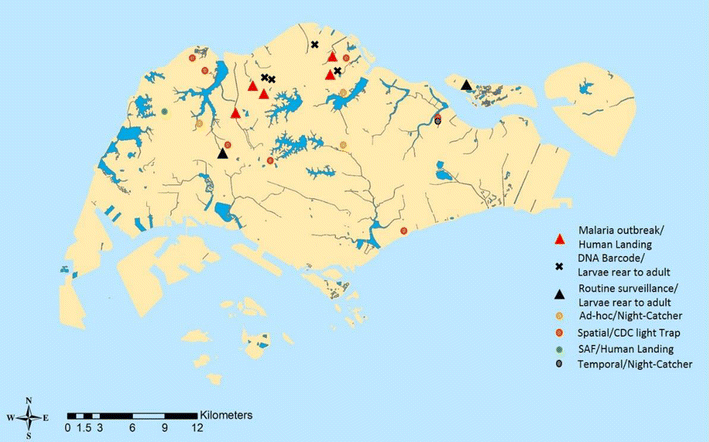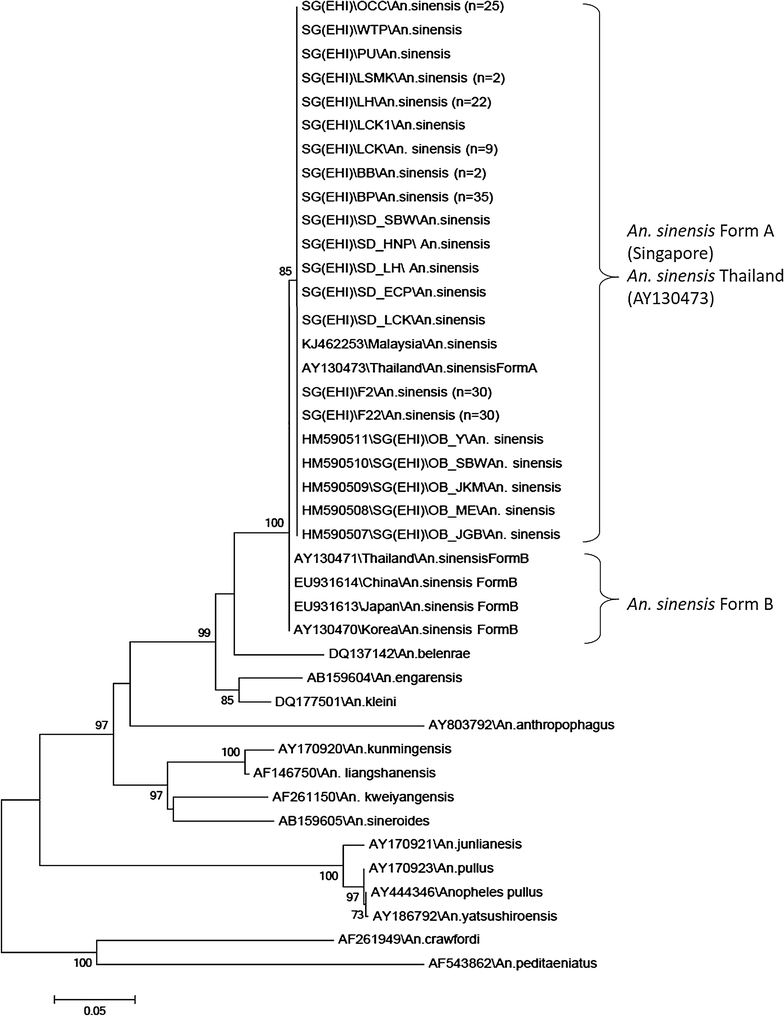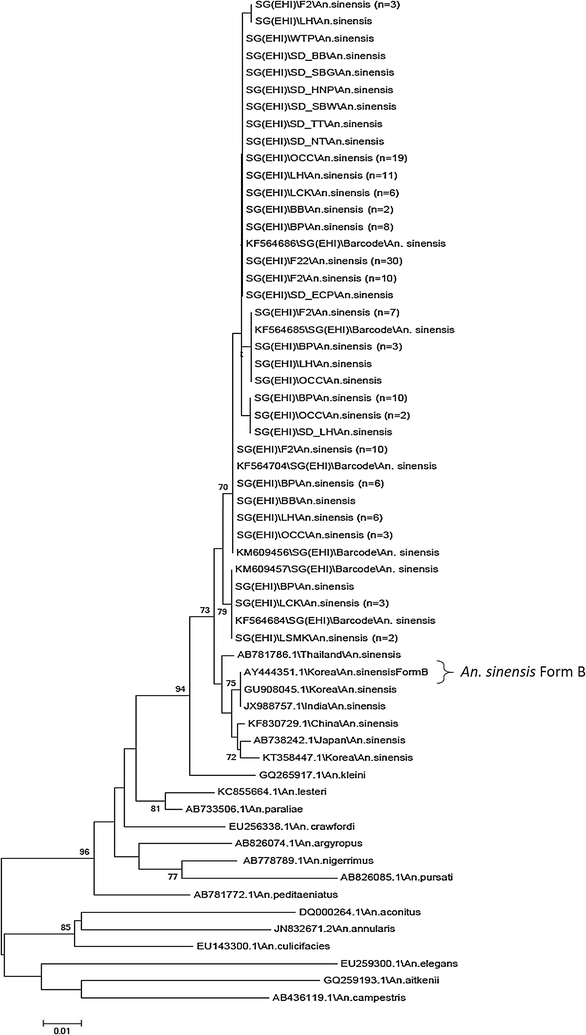Singapore's Anopheles sinensis Form A is susceptible to Plasmodium vivax isolates from the western Thailand-Myanmar border
- PMID: 29145859
- PMCID: PMC5689142
- DOI: 10.1186/s12936-017-2114-3
Singapore's Anopheles sinensis Form A is susceptible to Plasmodium vivax isolates from the western Thailand-Myanmar border
Abstract
Background: Singapore has been certified malaria-free by the World Health Organization since November 1982. However, sporadic autochthonous malaria outbreaks do occur. In one of the most recent outbreaks of vivax malaria, an entomological investigation identified Anopheles sinensis as the most probable vector. As metaphase karyotype studies divided An. sinensis into two forms, A and B, with different vector competence: the investigation of vector competence of An. sinensis found in Singapore was thus pursued using Plasmodium vivax field isolates from the Thailand-Myanmar border.
Methods: Adults and larvae An. sinensis were collected from Singapore from 14 different locations, using various trapping and collection methods between September 2013 and January 2016. Molecular identification of An. sinensis species were conducted by amplifying the ITS2 and CO1 region using PCR. Experimental infections of An. sinensis using blood from seven patients infected with P. vivax from the Thailand-Myanmar border were conducted with Anopheles cracens (An. dirus B) as control.
Results: Phylogenetic analysis showed that An. sinensis (F22, F2 and collected from outbreak areas) found in Singapore was entirely Form A, and closely related to An. sinensis Form A from Thailand. Artificial infection of these Singapore strain An. sinensis Form A resulted in the development of oocysts in four experiments, with the number of sporozoites produced by one An. sinensis ranging from 4301 to 14,538.
Conclusions: Infection experiments showed that An. sinensis Form A from Singapore was susceptible to Thai-Myanmar P. vivax strain, suggesting a potential role as a malaria vector in Singapore.
Keywords: An. cracens; Anopheles sinensis Form A; Infection; Malaria vector; Sporozoites.
Figures







Similar articles
-
Vector Competence of Anopheles kleini and Anopheles sinensis (Diptera: Culicidae) From the Republic of Korea to Vivax Malaria-Infected Blood From Patients From Thailand.J Med Entomol. 2016 Nov;53(6):1425-1432. doi: 10.1093/jme/tjw109. Epub 2016 Aug 4. J Med Entomol. 2016. PMID: 27493248
-
Imported Plasmodium falciparum and locally transmitted Plasmodium vivax: cross-border malaria transmission scenario in northwestern Thailand.Malar J. 2017 Jun 21;16(1):258. doi: 10.1186/s12936-017-1900-2. Malar J. 2017. PMID: 28637467 Free PMC article.
-
The susceptibility of Anopheles lesteri to infection with Korean strain of Plasmodium vivax.Malar J. 2009 Mar 12;8:42. doi: 10.1186/1475-2875-8-42. Malar J. 2009. PMID: 19284634 Free PMC article.
-
Susceptibility of Anopheles sinensis to Plasmodium vivax in malarial outbreak areas of central China.Parasit Vectors. 2013 Jun 14;6:176. doi: 10.1186/1756-3305-6-176. Parasit Vectors. 2013. PMID: 23768077 Free PMC article.
-
Prevalence of Plasmodium spp. in Anopheles mosquitoes in Thailand: a systematic review and meta-analysis.Parasit Vectors. 2022 Aug 6;15(1):285. doi: 10.1186/s13071-022-05397-2. Parasit Vectors. 2022. PMID: 35933389 Free PMC article.
Cited by
-
Morphological and molecular identification reveals a high diversity of Anopheles species in the forest region of the Cambodia-Laos border.Parasit Vectors. 2022 Mar 18;15(1):94. doi: 10.1186/s13071-022-05167-0. Parasit Vectors. 2022. PMID: 35303948 Free PMC article.
-
Mosquito abundance in relation to extremely high temperatures in urban and rural areas of Incheon Metropolitan City, South Korea from 2015 to 2020: an observational study.Parasit Vectors. 2021 Oct 29;14(1):559. doi: 10.1186/s13071-021-05071-z. Parasit Vectors. 2021. PMID: 34715902 Free PMC article.
-
Molecular phylogeny of the Anopheles hyrcanus group (Diptera: Culicidae) based on rDNA-ITS2 and mtDNA-COII.Parasit Vectors. 2021 Sep 6;14(1):454. doi: 10.1186/s13071-021-04971-4. Parasit Vectors. 2021. PMID: 34488860 Free PMC article.
-
Isolation and Genetic Characterization of Japanese Encephalitis Virus Two Decades after Its Elimination in Singapore.Viruses. 2022 Nov 28;14(12):2662. doi: 10.3390/v14122662. Viruses. 2022. PMID: 36560666 Free PMC article.
-
Mosquitoes (Diptera: Culicidae) of Singapore: Updated Checklist and New Records.J Med Entomol. 2019 Jan 8;56(1):103-119. doi: 10.1093/jme/tjy154. J Med Entomol. 2019. PMID: 30169704 Free PMC article.
References
-
- Brooke GE, Marckepeace WD, Braddel WD. One hundred years of Singapore. London; 1921.
-
- Goh KT. Eradication of malaria from Singapore. Singap Med J. 1983;24:255–268. - PubMed
-
- Chew PK. The outbreak of malaria at Fuyong Estate in Singapore. Singap Med J. 1968;9:111–126. - PubMed
-
- Chan KL, Goh KT, Koh TS. The Whampoa–Kallang malaria outbreak, 1974-5. Singap Med J. 1976;17:124–132. - PubMed
-
- Lin Yj, Badaruddin H, Ooi P-LS. Badaruddin H, Ooi P-LS. Epidemiology of malaria in Singapore, 2008–15. Epidemiol News Bull. 2016;42(2):49–54.
Publication types
MeSH terms
Grants and funding
LinkOut - more resources
Full Text Sources
Other Literature Sources
Research Materials
Miscellaneous

